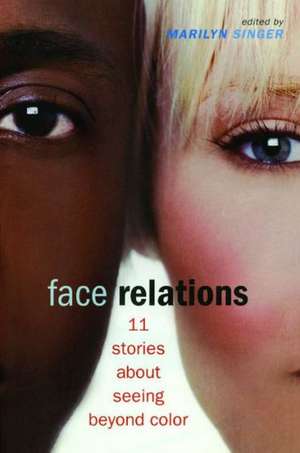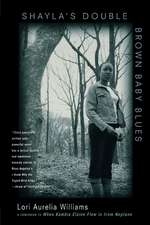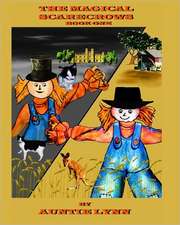Face Relations: 11 Stories About Seeing Beyond Color
Editat de Marilyn Singeren Limba Engleză Paperback – 4 mai 2013 – vârsta de la 12 ani
What happens when a biracial girl from Trinidad falls for a guy from a very different culture?
How does a teen deal with being the only Palestinian boy or the only Japanese girl in a small American town?
Face Relations offers eleven original works by celebrated authors Joseph Bruchac, Marina Budhos, M. E. Kerr, Kyoko Mori, Jess Mowry, Naomi Shihab Nye, René Saldaña Jr., Marilyn Singer, Rita Williams-Garcia, Sherri Winston, and Ellen Wittlinger that explore the possibilities of embracing diversity in a world still rife with bigotry and racism. As editor Marilyn Singer writes in her introduction:
"...the characters in these stories tear down the barriers that separate us." Their stories may be troubled, funny, sad, or fierce, but all are full of hope.
11 stories about seeing beyond color
> "Phat Acceptance" by Jess Mowry
> "Skins" by Joseph Bruchac
> "Snow" by Sherri Winston
> "The Heartbeat of the Soul of the World" by René Saldaña Jr.
> "Hum" by Naomi Shihab Nye
> "Epiphany" by Ellen Wittlinger
> "Black and White" by Kyoko Mori
> "Hearing Flower" by M. E. Kerr
> "Gold" by Marina Budhos
> "Mr. Ruben" by Rita Williams-Garcia
> "Negress" by Marilyn Singer
Preț: 73.04 lei
Nou
Puncte Express: 110
Preț estimativ în valută:
13.98€ • 14.63$ • 11.56£
13.98€ • 14.63$ • 11.56£
Carte disponibilă
Livrare economică 17-31 martie
Preluare comenzi: 021 569.72.76
Specificații
ISBN-13: 9781442496163
ISBN-10: 1442496169
Pagini: 240
Ilustrații: f-c cvr
Dimensiuni: 152 x 229 x 18 mm
Greutate: 0.27 kg
Editura: Simon & Schuster Books for Young Readers
Colecția Simon & Schuster Books for Young Readers
ISBN-10: 1442496169
Pagini: 240
Ilustrații: f-c cvr
Dimensiuni: 152 x 229 x 18 mm
Greutate: 0.27 kg
Editura: Simon & Schuster Books for Young Readers
Colecția Simon & Schuster Books for Young Readers
Extras
Introduction
I confess: I've been a Star Trek fan for years. I've watched every episode of every series, some more than once. The sight of the Enterprise, with its multiethnic, multiracial, multispecies crew, still fills me with hope.
But you don't have to be a Trekker to believe that we humans can learn to live with and value each other. One day I heard someone on the radio say that he felt "honored" to ride the New York City subways with people of so many heritages. I try to invoke that privilege even when I'm squished between hordes of commuters on the rush-hour Q train. Sometimes it works. Sometimes it doesn't. My goal is to keep trying.
I believe we all should keep trying to acknowledge, appreciate, and celebrate our diversity. But I've lived long enough -- and in probably the most diverse city in the world -- to know that this is seldom easy. Every day we have to uncover, examine, and fight the prejudices we've acquired, usually from early childhood on. Anyone who thinks we've eliminated racism and bigotry in the twenty-first century is asleep at the wheel. Racism -- the widespread system of advantage based on race -- is, unfortunately, still with us. So is bigotry -- prejudice based on race, creed, sex, etc. We have to struggle daily against feelings of fear and powerlessness, inertia, group pressure, and the constant bombardment of negative stereotypes, both obvious and subtle, to change ourselves, and others, too. Which brings me to this book.
Face Relations: 11 Stories About Seeing Beyond Color is not a book about prejudice (although prejudice is most certainly an important part of this book). It is about the possibilities of embracing diversity. With naivete, ambivalence, intent, anger, fear, embarrassment, and joy, the characters in these stories tear down the barriers that separate us.
In Jess Mowry's "Phat Acceptance," meet Brandon, a guy with that cool white surfer-dude look -- even if he isn't a surfer -- whose first day in a new school is turned upside down by the arrival of the one, the only, the fattest black classmate he's ever seen. And there's Mitch, narrator of Joseph Bruchac's "Skins," a football player of Native American and Scandinavian heritage, whose strategy of "hanging back" is challenged by the two new kids in town: Randolph, clearly African-American, and Jimmy T, purely American Indian. Or are they?
Get to know DeMaris -- pining for her best friend Epiphany, the title character in Ellen Wittlinger's story -- who dares to ask: Why can't a white girl sit with the black kids in the cafeteria? In Noelle's school, some of the black kids aren't allowed to sit with the black kids. Sherri Winston, in her story "Snow," introduces us to this budding journalist whose fight against the mistreatment of Haitian students by fellow African-American classmates leads her to a dangerous clash with the school principal.
Kyoko Mori's protagonist in "Black and White" tells the story of an "outsider" from an immigrant's own perspective. Born in Japan and growing up in rural Wisconsin, Asako learns that being the misunderstood "foreigner" doesn't excuse her act of mean-spirited Halloween vandalism.
Then there are Jemma, also an immigrant, in Marina Budhos's "Gold," and Bianca, living amid immigrants, in M. E. Kerr's "Hearing Flower." One is biracial and poor, the other rich and white, but each has suffered the loss of a parent and each is in love with the "wrong" boy.
At least these boys are the right age. What are we to make of Myra with a thing for her math teacher, Rita Williams-Garcia's "Mr. Ruben." No one can tell what race Mr. Ruben is. But poor Myra, she just can't have a crush on the man unless he's black -- and she'll drive herself and her friend Dee crazy until she finds out if he is or not.
Myra's situation makes us laugh. PD's does not. He was a promising Latino trumpet player. Now, he's dead. But oh, what he's left behind! René Saldaña Jr.'s moving story "The Heartbeat of the Soul of the World" is about PD's legacy -- and the unifying power of music.
A very different soul hovers over Beth and Vonny in my own story "Negress" -- the ghost of Saartjie Baartman, the Hottentot Venus, a woman exhibited as a sexual freak throughout Europe in the early nineteenth century. Will her spirit unite or divide these two very different best friends? What possibilities does she have in store for them?
In Naomi Shihab Nye's "Hum," Sami is haunted by spirits too -- spirits of the dead and the living he left behind in the Middle East. But he and his family are hopeful about their new life in Texas. And then comes the day that changes everything: September 11, 2001.
These characters' -- these writers' -- stories are troubled, sad, touching, funny, or fierce, but all are full of hope. And if hope really is, in Emily Dickinson's words, "the thing with feathers / That perches in the soul / And sings the tune without the words / And never stops at all," may these stories supply some possible lyrics. May you hear their words and music long after you close this book.
Marilyn Singer
Copyright © 2004 by Marilyn Singer
I confess: I've been a Star Trek fan for years. I've watched every episode of every series, some more than once. The sight of the Enterprise, with its multiethnic, multiracial, multispecies crew, still fills me with hope.
But you don't have to be a Trekker to believe that we humans can learn to live with and value each other. One day I heard someone on the radio say that he felt "honored" to ride the New York City subways with people of so many heritages. I try to invoke that privilege even when I'm squished between hordes of commuters on the rush-hour Q train. Sometimes it works. Sometimes it doesn't. My goal is to keep trying.
I believe we all should keep trying to acknowledge, appreciate, and celebrate our diversity. But I've lived long enough -- and in probably the most diverse city in the world -- to know that this is seldom easy. Every day we have to uncover, examine, and fight the prejudices we've acquired, usually from early childhood on. Anyone who thinks we've eliminated racism and bigotry in the twenty-first century is asleep at the wheel. Racism -- the widespread system of advantage based on race -- is, unfortunately, still with us. So is bigotry -- prejudice based on race, creed, sex, etc. We have to struggle daily against feelings of fear and powerlessness, inertia, group pressure, and the constant bombardment of negative stereotypes, both obvious and subtle, to change ourselves, and others, too. Which brings me to this book.
Face Relations: 11 Stories About Seeing Beyond Color is not a book about prejudice (although prejudice is most certainly an important part of this book). It is about the possibilities of embracing diversity. With naivete, ambivalence, intent, anger, fear, embarrassment, and joy, the characters in these stories tear down the barriers that separate us.
In Jess Mowry's "Phat Acceptance," meet Brandon, a guy with that cool white surfer-dude look -- even if he isn't a surfer -- whose first day in a new school is turned upside down by the arrival of the one, the only, the fattest black classmate he's ever seen. And there's Mitch, narrator of Joseph Bruchac's "Skins," a football player of Native American and Scandinavian heritage, whose strategy of "hanging back" is challenged by the two new kids in town: Randolph, clearly African-American, and Jimmy T, purely American Indian. Or are they?
Get to know DeMaris -- pining for her best friend Epiphany, the title character in Ellen Wittlinger's story -- who dares to ask: Why can't a white girl sit with the black kids in the cafeteria? In Noelle's school, some of the black kids aren't allowed to sit with the black kids. Sherri Winston, in her story "Snow," introduces us to this budding journalist whose fight against the mistreatment of Haitian students by fellow African-American classmates leads her to a dangerous clash with the school principal.
Kyoko Mori's protagonist in "Black and White" tells the story of an "outsider" from an immigrant's own perspective. Born in Japan and growing up in rural Wisconsin, Asako learns that being the misunderstood "foreigner" doesn't excuse her act of mean-spirited Halloween vandalism.
Then there are Jemma, also an immigrant, in Marina Budhos's "Gold," and Bianca, living amid immigrants, in M. E. Kerr's "Hearing Flower." One is biracial and poor, the other rich and white, but each has suffered the loss of a parent and each is in love with the "wrong" boy.
At least these boys are the right age. What are we to make of Myra with a thing for her math teacher, Rita Williams-Garcia's "Mr. Ruben." No one can tell what race Mr. Ruben is. But poor Myra, she just can't have a crush on the man unless he's black -- and she'll drive herself and her friend Dee crazy until she finds out if he is or not.
Myra's situation makes us laugh. PD's does not. He was a promising Latino trumpet player. Now, he's dead. But oh, what he's left behind! René Saldaña Jr.'s moving story "The Heartbeat of the Soul of the World" is about PD's legacy -- and the unifying power of music.
A very different soul hovers over Beth and Vonny in my own story "Negress" -- the ghost of Saartjie Baartman, the Hottentot Venus, a woman exhibited as a sexual freak throughout Europe in the early nineteenth century. Will her spirit unite or divide these two very different best friends? What possibilities does she have in store for them?
In Naomi Shihab Nye's "Hum," Sami is haunted by spirits too -- spirits of the dead and the living he left behind in the Middle East. But he and his family are hopeful about their new life in Texas. And then comes the day that changes everything: September 11, 2001.
These characters' -- these writers' -- stories are troubled, sad, touching, funny, or fierce, but all are full of hope. And if hope really is, in Emily Dickinson's words, "the thing with feathers / That perches in the soul / And sings the tune without the words / And never stops at all," may these stories supply some possible lyrics. May you hear their words and music long after you close this book.
Marilyn Singer
Copyright © 2004 by Marilyn Singer
Cuprins
Contents
Introduction
Letter from the Southern Poverty Law Center
Phat Acceptance by Jess Mowry
Skins by Joseph Bruchac
Snow by Sherri Winston
The Heartbeat of the Soul of the World by René Saldaña Jr.
Hum by Naomi Shihab Nye
Epiphany by Ellen Wittlinger
Black and White by Kyoko Mori
Hearing Flower by M. E. Kerr
Gold by Marina Budhos
Mr. Ruben by Rita Williams-Garcia
Negress by Marilyn Singer
About the Authors and Their Stories
Introduction
Letter from the Southern Poverty Law Center
Phat Acceptance by Jess Mowry
Skins by Joseph Bruchac
Snow by Sherri Winston
The Heartbeat of the Soul of the World by René Saldaña Jr.
Hum by Naomi Shihab Nye
Epiphany by Ellen Wittlinger
Black and White by Kyoko Mori
Hearing Flower by M. E. Kerr
Gold by Marina Budhos
Mr. Ruben by Rita Williams-Garcia
Negress by Marilyn Singer
About the Authors and Their Stories
Notă biografică
Author of more than one hundred books in many genres, Marilyn Singer is the winner of the 2015 NCTE Award for Excellence in Poetry for Children. Her works include Mirror, Mirror, which was an ALA Notable Book, won the Cybils Award for poetry, and was on eight major best-books-of-the-year lists; Venom, an NCTE Orbis Pictus Honor Book for Outstanding Nonfiction for Children; Fireflies at Midnight, a School Library Journal Best Book; and Tallulah's Tutu and its sequels. She lives in Brooklyn, New York, and Washington, Connecticut, with her husband and several pets. Visit MarilynSinger.net.








